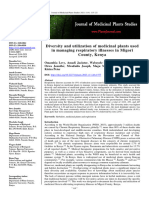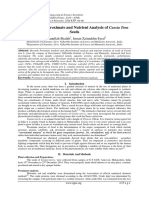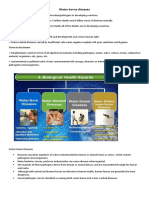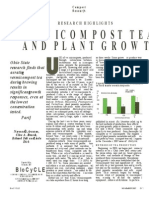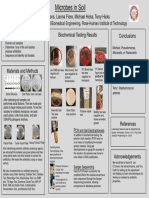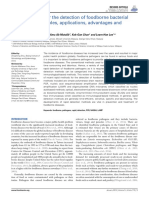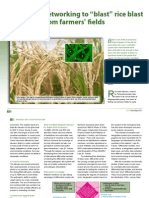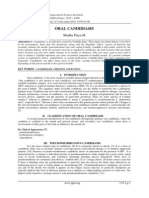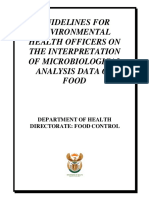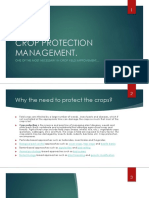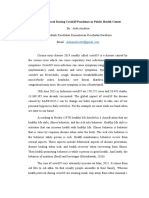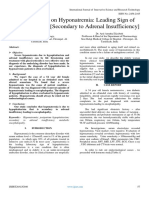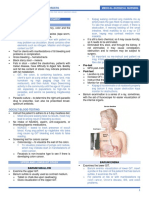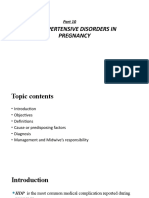Professional Documents
Culture Documents
Isolation and Identification of Fungi Associated With The Spoilage of Cucumber Fruit Sold in Igbariam, Anambra State and Possible Control Method Using Lime Juice Extract
Original Title
Copyright
Available Formats
Share this document
Did you find this document useful?
Is this content inappropriate?
Report this DocumentCopyright:
Available Formats
Isolation and Identification of Fungi Associated With The Spoilage of Cucumber Fruit Sold in Igbariam, Anambra State and Possible Control Method Using Lime Juice Extract
Copyright:
Available Formats
Volume 6, Issue 4, April – 2021 International Journal of Innovative Science and Research Technology
ISSN No:-2456-2165
Isolation and Identification of Fungi Associated with
the Spoilage of Cucumber Fruit Sold in Igbariam,
Anambra State and Possible Control Method Using
Lime Juice Extract
Ejimofor Chiamaka Frances1, Oledibe Odira Johnson 2*
1
Department of Biological Sciences, Chukwuemeka Odumegwu University, Uli, Anambra State, Nigeria.
2
*Corresponding author, Department of Botany, Nnamdi Azikiwe University, Awka, Anambra State, Nigeria.
Abstract:- Fruits and vegetables are generally very vital to this family include Melon, squash, Watermelon and
to the human system due to their various minerals and Pumpkins [2]. It originated from the Asia continent.
vitamin contents. Some of them are more nutritious than Cucumber plant can be cultivated in both temperate
others and are in higher demands. This study was and tropical environment hence it is said to be a native
conducted to isolate and identify fungi associated with of many regions of the world [3,4].
the spoilages of cucumber fruit sold in Igbariam. The
pesticidal control method using lime juice extract was The fruit is normally consumed raw alone or eaten
also examined.The samples (cucumber) were analyzed with other vegetables such as salad in Nigeria [5].
and examined using standard laboratory procedures. Cucumber is majorly cultivated because of its nutritional
Ethanol was used in extraction of the lime juice while and medicinal relevance. Seed kernels are occasionally
chloramphenicol was used as control. The result of the eaten [6].
analysis showed fungual pathogen such as mold,
Aspergilius spp, Fusarium spp and Alternaeria spp were Cucumber (Cucumis sativus L.) is one of the most
found to be associated with spoilage in cucumber. The important economic vegetable crops all over the world. It is
result also showed that ethanol extract of lime juice tend cultivated in open fields and protected houses in Egypt for
to have good inhibitory effect on these organism, but a both local consumption and export. The occurrence of
better inhibition level is noted at 6mg/l which is fungal spoilage of fruits is recognized as a potential health
significant at p<0.05%. Lime juice extract showed the hazard to man due to their production of mycotoxins [7].
highest good inhibitory effect on mold (12mm) and
lowest on Aspergillus spp (6 mm) at 6mg/ml while Cucumber plants are subject to attack by several
chloramphenicol showed the highest good inhibitory fungal diseases that affect the yield quantity and quality
effect on Alternaeria spp (3.2mm) and lowest on including Alternaria tenuis, A. alternata, Botrytis cinerea,
Fusarium spp (1mm). This showed that the lime juice Choanephora cucurbitarum, Didymella bryoniae, Fusarium
extract have antifungal properties that can be helpful in oxysporum, Geotrichum candidum, Penicillium oxalicum,
the control and management of scab fungi of apple Phytophthora capsici, Rhizopus nigricans and Sphaerotheca
fruit.Therefore, the study recommended that farmer fuliginea [8,9,10,11].
should use lime juice for the control of fungi rot
organisms associated with cucumber and has the The ability of public health agencies to identify
potentials of causing damage loss of cucumber. through enhanced epidemiological and surveillance
techniques, raw vegetables as probable sources of infectious
Keywords:- Cucumber, Lime Juice, Fungi. microorganisms has undoubtedly resulted in increased
numbers of documented outbreaks. The risk of illness
I. INTRODUCTION associated with raw vegetable products can be reduced by
removing or killing pathogenic microorganisms by washing
Cucumber (Cucumis sativus L.) is an important or treating them with sanitizers. However, the hydrophobic
vegetable used to be cultivated once annually during the cutin, diverse surface morphologies and abrasions in the
rainy season in Nigeria. It is an important vegetable epidermis of fruits and vegetables limits the efficacy of this
cultivated in Northern central, Nigeria both in rainy and treatment [12].
dry season using irrigation. The fruits serves as
refreshments during farming activities [1]. Vegetables are frequently consumed raw without being
exposed to the processes that reliably eliminates pathogens.
Cucumber is a creeping vine that bears cylindrical Washing fruits and vegetables in chlorinated water can
fruits. It is known as Cucumis sativus L, it belongs to the reduce bacterial levels but cannot be relied upon to eliminate
gourd family cucubitacea Other vegetables which belong pathogens. Eating or drinking contaminated foods or drinks
IJISRT21APR340 www.ijisrt.com 690
Volume 6, Issue 4, April – 2021 International Journal of Innovative Science and Research Technology
ISSN No:-2456-2165
can cause foodborne disease. Many different types of incubation period, the observed growth was subculture to
bacteria, viruses and parasites can contaminate food, so get a pure culture.
there is numerous different food borne infections. The
consumption of carrot, cucumber, onions and cabbage in 2.4 Colony Count
Nigeria has increased tremendously in the recent years The direct colony count method was used. In this
properly due to increased awareness on their health method, the colonies of fungi were counted directly from the
important. Carrot is known to contain an important cultured plate.
biologically active compound, carotenoid [13].
2.5 Identification of Fungi Isolate
Cucumber fruit rot is not only a challenge to the Both morphological and anatomical characteristics of
farmers but also the vegetable and fruit vendors who will the fungi were used in the identification process of the fungi
have to shelf it for sometimes in the course of selling. Rot isolate. This was done as follows.
occurring on shelf reduces shelf life and market value and
altogether renders fruits unfit for human consumption. There A: Morphological identification Methods of as described
is paucity of information on fungi associated with or by Cheesebrough [14]: The growth pattern and pigments
responsible for spoilage of cucumber fruits in the Nigeria, produced by the fungi was observed, match against those in
especially in Igbariam, Awka Anambra state. It as result of fungi identification kit and recorded accordingly.
this that this study focus on isolation and identification of B: Anatomical Identification: Here, guides according to
fungi associated with the spoilage of cucumber fruit sold in Alexopoulos [15] were used for the various tests and
Igbariam and the pesticidial control method using lime juice examinations. A smear of the fungi growth was fix on two
different slide and stained with distil water and lacto phenol.
II. MATERIALS AND METHOD Both of the smears were viewed under binocular microscope
and the anatomical characteristic recorded and as well match
The samples lime and cucumber were all purchased against those on fungi identification kit then identified
from Igbariam and transported in a sterile bag to Maeve accordingly.
academic research laboratory where it was identified before
being analysed in the laboratory. 2.6 Pathogenicity Test
The pathogenicity test was carried out to establish
2.1 Experimental Equipment which of the fungal isolates caused the rot and to determine
The equipment’s used in the experiment includes, whether they could induce similar symptoms on inoculation
autoclave, knife, binocular microscope, microscopic slide, and be re-isolated, thus fulfilling Koch’s postulates. The
slid cover, conical flask, 250ml and 500ml beaker, method of Okafor [16], Okigbo and Ikediugwu [17] were
inoculating loop, cotton wool, cork borer, foil, burnson adopted for the pathogenicity study.
burner petri dish and masking tape.
Pure culture of the fungi was isolated using inoculation
2.2 Experimental Reagents loop of length 5cm while a healthy apple fruit was surface
The reagents used includes Distil water, Ethanol, sterilized using 100% ethanol. With the use of cork borer, a
lactophenol, Potato Dextrox agar ( PDA). smooth deep cut was made on the healthy yam tuber to a
depth of 2cm with a diameter of 10mm wide. The pure
2.3 Samples Preparation Procedure culture of the fungi was inoculated and the 10mm cover of
the initial cut healthy apple fruit part was used to cover it.
2.3.1 Preparation of the samples The sample was kept in an incubation chamber for 72hr then
The surface of the sample was first surface sterilized being observed every 3 days to ascertain the pathogenicity
with 70% alcohol and the infected portion cut off into small of the organism.
pieces of size 3cm by 3cm then kept in beaker ready for use.
The cucumber fruit was grounded into paste under room 2.7 Anti-microbial Assay
temperature at 25± 10c and kept in 150ml beaker ready for Effect of plant extract on mycelia growth of the test
inoculation into culture media. The lime juice was extracted fungi was studied using the food poisoning techniques [18].
manually from the lime orange fruit through cold press 4mg/l, 6mg/l and 8mg/l of the plant extract were pipetted
method and well kept in 150ml beaker. into labelled petri dishes containing the pure culture of the
microbial organism respectively. The Inhibition zones of the
2.3.2 Preparation Of Culture Media microorganism was evaluated and recorded in terms of
The method was employed and used in the preparation radial growth of the microbes on the medium with and
of the culture media. One gram of potato dextros agar without extracts and results were analysed on the basis of
(PDA) was dissolved in 45ml of distil water, then percentage growth Zone inhibitions of microorganisms. The
autoclaved for 15min under the pressure of 15 pounds inhibition of microbial growth on PDA medium was used to
pressure(psi) at a temperature of 1210C. The media was quantify the toxicity of extracts. Percentage growth
poured into petri dish and allowed to cool into cake form inhibition for 5 days was calculated.
ready for inoculation. The prepared apple sample that was
cut from off from the infected surface was inoculated culture % growth inhibition = R1 – R2 X 100
media and incubated for 72hours for growth. After the R2
IJISRT21APR340 www.ijisrt.com 691
Volume 6, Issue 4, April – 2021 International Journal of Innovative Science and Research Technology
ISSN No:-2456-2165
Where R1 = is the furthest radial distance of pathogens in Fig 1, shows that Alternaeria spp is highly inhibited by
control plates the extract followed by Fusarium spp, while Aspergilius spp
Where R2 = is the furthest radial distance of pathogens in and mold fungi are not really inhibited.
extract (treated) plates. The inhibition percentage was
determined as a guide in selecting the minimum inhibition
concentration that will be effective in controlling the
microbial organisms.
2.8 Statistical Analysis
Data collected were subjected to two-way analysis of
variance (ANOVA) with the use of Sigmaplot version 12
statistical software to ascertain the level of significance of
the treatment given to at LSD0.05% .
III. RESULTS
Table 4.1 Anti-Microbial Inhibition zone of lime juice
Microorganism 4mg/ml 6mg/ml Control
(Chloramphenico
l)
Aspergilius spp 3mm 6 mm 3.1mm
Fusarrium spp 5mm 8mm 1mm Fig 2: Zone of inhibition fungi organism treated with
Mold 3.mm 12mm 3mm lime juice extract at 6mg/l
Alternaeria spp 7mm 9mm 3.2mm
Fig 2 shows that at 6mg/l mold fungi is highly
Table 4.1 shows that the fungi rot organism isolated inhibited followed by Alternaeria spp and Fusarium spp and
from cucumber included Aspergilius spp, Fusarrium spp, least in Aspergilius spp. This mean that at concentration of
mold and Alternateria spp. This fungi were noted to be at 6mg/l there will be more inhibition of the mold and
different dosage with corresponding inhibition zone. alternaeria spp
Aspergilius spp was seen to be inhibited up 3mm at 4mg/l,
fusarium is 5mg/l, mold fungi, 3mm and Alternaeria spp Table 4.2:Two-Way ANOVA
7mm. at 6mg/l Aspergilius spp was inhibited up to 6mm
Fusarium spp 8mm, mold fungi was highly inhibited as
indicated by 12mm zone of inhibition while Aternaeria spp
is 9mm. the control experiment inhibition is less than the
extract inhibition level. This indicates that lime juice has a
significant effect on the fungi as a control method.
Tested at 0.05% level of significance
Table 4.2 shows that the treatment dosages of 4mg/l
and 6mg/l are all significant at p<0.05% . This means that
at both dosages, the fungi organisms of cucumber is
inhibited.
Table 4.3: Least significant mean differences for
treatment Dosage
Result are in mean± standard deviation (LSD0.05%)
Table 4.3 shows that treatment dosage of 6mg/l has the
highest mean value which as compared to 4mg/l. this infers
that 6mg/l is a better treatment dosage for the control of
cucumber rot fungi.
Fig 1: Zone of inhibition fungi organism treated with
lime juice extract at 4mg/l
IJISRT21APR340 www.ijisrt.com 692
Volume 6, Issue 4, April – 2021 International Journal of Innovative Science and Research Technology
ISSN No:-2456-2165
Plate 1: Colonies of Cultured Fungi Plate 4: Pure culture of Alternaeria spp
Plate 2: Pure culture of Aspergilius spp Plate 5: Microscopic view of Alternaeria spp(x10)
Plate 3: Pure Culture of mold fungi Plate 6: Microscopic view of mold fungi(x10)
IJISRT21APR340 www.ijisrt.com 693
Volume 6, Issue 4, April – 2021 International Journal of Innovative Science and Research Technology
ISSN No:-2456-2165
REFERENCES
[1]. Jidda M.B, Muhammad M.M (2017). Assessment of
fungal pathogens associated with spoilage of cucumber
(Cucumis sativu L.) fruits. International Journal of
Current Micro-biology Applied Science 6(3):510-516.
[2]. Bello M.O, Owoeye G, Abdulhammed M, Yekeen T.A
(2014). Characterization of gourd fruit (Cucubitaceae)
for dietary values and anti-nutrition constituent.
Journal of Pharmaceutical Biology Chemistry
Science.6:7575-7585.
[3]. Abulude O A, Adeleke K O (2010). Comparative
studies on nutritional composition
offourmelonseedsvarieties.PakistanJournalofNutrition.
9:905-908
[4]. Mortimore M (2015). Dry land developer’s success
stories from West Africa environment. Journal of
Biological Science. 45:10-21.
[5]. Ibrahim M, Sada MD (2015). Yeasts associated with
spoilage of some selected fruits in Sokoto
Plate 7: Microscopic view of Aspergilius spp(x10)
Metropolis.Available:
http://scienceq.org/Journals/JALS.php (Accessed 10th
IV. DISCUSSION
September, 2019)
[6]. Aboloma RI, Onifade AK, Adetuyi FC (2009). Fungi
The findings of the study showed that Aspergilus spp,
Fusarium spp, mold fungi and Alternaeria spp are the fungi associated with the deterioration of some fruits of the
family Cucurbitaceae. Nigerian Journal of Mycolog.
organisms that are found associated with cucumber fruits.
2:229-236.
These fungi were all noted to be inhibited at treatment
[7]. Effiuvwevwere B.J.O. (2000). Microbial Spoilage
dosage of lime extract at 4mg/l and 6mg. This inhibition
level were also noted to be significant at P<0.05%. Finding Agents of Tropical and Assorted fruits and Vegetables
(An Illustrated References Book). Paragraphics
from the least significant difference (LSD 0.05%) shows that
Publishing Company, Port Harcourt, Nigeria, 39 pp.
treatment dosage of the lime extract at6mg/l is far better
than that of 4mg/l. This effect may be due to the medicinal [8]. Blancard D., Lecoq H., Pitrat M. 2005. A color atlas of
properties of the lime juice extract. This finding agree with cucurbit diseases observation, identification and
control Manson Publishing Ltd. London, United
the finding of Chinen-chun and Chukunda [19],who
Kingdom, 304 pp.
reported that plant extracts like lime and Lemongrass oil is
[9]. Farrag E.S.H., Ziedan E.H., Mahmoud S.Y.M. 2007.
used to control turtle borne pathogen and can also change
the activities of drug metabolizing enzymes and reduce Systemic acquired resistance induced in cucumber
plants against powdery mildew disease by pre-
oxidative stress in the liver . The findings also agree with
inoculation with tobacco necrosis virus. Plant
the findings of Verma and Onyike [20] who also said that
alcoholic extract of ripe dried plants like lime, coconut shell Pathology Journal 6 (1): 44−50.
DOI:10.3923/ppj.2007.44.50
have action against Microsporum canis, M. gypseum, M.
audouinii, Trichophyton mentagrophytes, T. rubrum, T. [10]. Sani M.A., Usman N., Kabir F., Kutama A.S. 2015.
tonsurans, and T. violaceum. The effect of three natural preservatives on the growth
of some predominant fungi associated with the
spoilage of fruits (Mango, Pineapple and Cucumber)
V. CONCLUSION
Global Advanced Results Journal of Agricultural
It’s evident from the study that, there are various fungi Sciences 4 (12): 923−928
organisms found associated with cucumber fruit which [11]. Ziedan E.H.E., Saad M.M. 2016. Efficacy of
causes damage to the fruit vegetable. This fungi can as well nanoparticles on seed borne fungi and their
be controlled effectively using lime juice at a higher pathological potential of cucumber. International
Journal of PharmTech Research 9 (10): 16−24.
concentration. Which means that to effectively control fungi
[12]. Burnett and Beuchat. Emerging infectious Diseases.
rot organism of cucumber, there is a need to use high
concentration of lime juice. Produce Handling and Processing Practices. 2001; 5:6
[13]. Asagbra A and Oyewole OB. Fermentation studies on
carrot juice processed to table wine. Nigeria‘s food
Journal, 2002; 20:74-77.
IJISRT21APR340 www.ijisrt.com 694
Volume 6, Issue 4, April – 2021 International Journal of Innovative Science and Research Technology
ISSN No:-2456-2165
[14]. Cheesbrough M (1984), District laboratory practice in
tropical countries. Part 2. London: Cambridge
University Press; p. 134–242.
[15]. Alexopoulos CJ (1962). Introductory mycology. 2nd
ed. Sydney: Wiley; p. 119–59
[16]. Okafor N. Microbial rotting of stored yam
(Dioscorea spp) in Nigeria. Exp Agric. 1966;2:179–
82.
[17]. Okigbo RN, Ikediugwu FEO. Studies on biological
control of post-harvest rot of yam (Dioscorea sp.)
with Trichoderma viride. J Phytopathol.
2000;148:351–5.
[18]. Sangoyomi TE, Ekpo EJA, Asiedu R. Fungitoxic
effects and attributes of Allium sativum and Occimum
gratissimum extracts on Rhizoctonia solani, the causal
organism of yam Dioscorea rotundata (Poir) rot
disease. Niger J Mycol. 2009;2(1):166–7.
[19]. Chinen-chun, B.A. and Chukunda, F.A. (2018).
Influence of some macro-elements, moisture and
oxalic acid on rot of Cocoyam (Colocasia and
Xanthosoma species). Int’l J. Crop Science 3(1): 10 –
14.
[20]. Verma , J.N.C. and Onyike R.C.I, (2012). Fungal
rotting of cocoyams in storage in Nigeria. Tropical
root crops: Research strategies for the 1980’s (Terry
E.R; K. AOduro and F. Cavenesseds) pp 235-238.
IJISRT21APR340 www.ijisrt.com 695
You might also like
- Introducing Mushroom Biotechnology in Goa-By Nandkumar KamatDocument9 pagesIntroducing Mushroom Biotechnology in Goa-By Nandkumar Kamatnandkamat100% (2)
- Module 4 Annex Part 1 MKDocument95 pagesModule 4 Annex Part 1 MKtata_77No ratings yet
- Isolation and Characterization of Endophytic Microbiome From Indigenous Maize (Zee Mays) Variety of Manipur and Its Impact On Biological ControlDocument7 pagesIsolation and Characterization of Endophytic Microbiome From Indigenous Maize (Zee Mays) Variety of Manipur and Its Impact On Biological ControlInternational Journal of Human Genetics Medical Biotechnology & Microbiological StudiesNo ratings yet
- Production of Wine From Banana: Waffen-Und Kostumkunde Journal ISSN NO: 0042-9945Document21 pagesProduction of Wine From Banana: Waffen-Und Kostumkunde Journal ISSN NO: 0042-9945Jerico D. Campos100% (1)
- Medicinal Plants: A Review: Journal of Plant SciencesDocument6 pagesMedicinal Plants: A Review: Journal of Plant Scienceskeshav shishyaNo ratings yet
- Blotter Test MethodDocument3 pagesBlotter Test MethodHil MaNo ratings yet
- Diversity and Utilization of Medicinal Plants Used in Managing Respiratory Illnesses in Migori CountyDocument7 pagesDiversity and Utilization of Medicinal Plants Used in Managing Respiratory Illnesses in Migori CountyLevy OmambiaNo ratings yet
- Alternative Culture Media For Bacterial Growth Using Different Formulation of Protein SourcesDocument4 pagesAlternative Culture Media For Bacterial Growth Using Different Formulation of Protein SourcesMasitha Dwi AmiraNo ratings yet
- History of Plant Pathology LectureDocument16 pagesHistory of Plant Pathology LectureAmitesh ChouhanNo ratings yet
- Phytochemical, Proximate and Nutrient Analysis of Cassia Tora SeedsDocument3 pagesPhytochemical, Proximate and Nutrient Analysis of Cassia Tora SeedsinventionjournalsNo ratings yet
- Water Borne Diseases: The Importance of Water QualityDocument3 pagesWater Borne Diseases: The Importance of Water QualityNeddie Lyn FranciscoNo ratings yet
- Rice Tungro VirusDocument35 pagesRice Tungro VirusJESRYL PAULITENo ratings yet
- Transforming Our Future - The Microbiome Conference ReportDocument26 pagesTransforming Our Future - The Microbiome Conference ReportValerianMendonca100% (1)
- Course Details: Course Details:: Course Coordinator: Email: Office Location: Other LecturersDocument5 pagesCourse Details: Course Details:: Course Coordinator: Email: Office Location: Other LecturersLokesh AhirwarNo ratings yet
- Natural Products From Bacteria and FungiDocument10 pagesNatural Products From Bacteria and FungiCat MeowNo ratings yet
- Secondary MetabolliteDocument20 pagesSecondary MetabolliteChindieyciiEy Lebaiey CwekZrdoghNo ratings yet
- Insecticidal Property of Extract of Piper NigrumDocument6 pagesInsecticidal Property of Extract of Piper NigrumOliver TalipNo ratings yet
- NTCC DeepakDocument21 pagesNTCC DeepakDeepak KumarNo ratings yet
- RT Vol. 7, No. 1 The Pesticide ParadoxDocument2 pagesRT Vol. 7, No. 1 The Pesticide ParadoxRice TodayNo ratings yet
- Effectiveness of Gallus Gallus Domesticus Eggshells As An Antibacterial Component of Hand SoapDocument71 pagesEffectiveness of Gallus Gallus Domesticus Eggshells As An Antibacterial Component of Hand SoapGabriel Christopher MembrilloNo ratings yet
- Eu PDFDocument36 pagesEu PDFhasmikNo ratings yet
- 1 Vermi Compost Tea Production 0001Document1 page1 Vermi Compost Tea Production 0001Gary L. NicholsNo ratings yet
- Their Potential PGPR ReviewDocument19 pagesTheir Potential PGPR ReviewMohammad Mosharraf HossainNo ratings yet
- New Developments in Chromogenic and Fluorogenic Culture MediaDocument14 pagesNew Developments in Chromogenic and Fluorogenic Culture MediaPaulina LizzethNo ratings yet
- PN ChromogenicMediaDocument12 pagesPN ChromogenicMediaNguyen Ngoc ThachNo ratings yet
- Using Endophytes To Enhance Golf's TurfgrassesDocument5 pagesUsing Endophytes To Enhance Golf's TurfgrassesAvinash SinghNo ratings yet
- Rhizosphere Microbiome EngineeringDocument16 pagesRhizosphere Microbiome EngineeringNatalie Sarah MoonNo ratings yet
- Lab ReportDocument15 pagesLab ReportValentinoDullSatinNo ratings yet
- Rootstock Breeding in GrapesDocument22 pagesRootstock Breeding in GrapesGopu ChiyaanNo ratings yet
- Microbiology PosterDocument1 pageMicrobiology Posterapi-577806584No ratings yet
- Bacterial Endophytes: Recent Developments and ApplicationsDocument9 pagesBacterial Endophytes: Recent Developments and ApplicationsmaczweiNo ratings yet
- TomatoDocument12 pagesTomatoAileen MontuyaNo ratings yet
- B38dbbaccfpractical - Ma Kharif 2 PDFDocument66 pagesB38dbbaccfpractical - Ma Kharif 2 PDFTejindarjit Kaur Gill BahgaNo ratings yet
- ATCC - Bacterial - Culture - Guide Cepas ATCC PDFDocument36 pagesATCC - Bacterial - Culture - Guide Cepas ATCC PDFjoshikoNo ratings yet
- Rapid Methods For The Detection of Foodborne Bacterial PathogensDocument19 pagesRapid Methods For The Detection of Foodborne Bacterial PathogensIoana MoldovanNo ratings yet
- Networking To "Blast" Rice Blast From Farmers' FieldsDocument3 pagesNetworking To "Blast" Rice Blast From Farmers' FieldsIRRI_resourcesNo ratings yet
- Rice Blast PaperDocument59 pagesRice Blast PaperDr. Parmeshwar SahuNo ratings yet
- Plant Growth Promoting RhizobacteriaDocument6 pagesPlant Growth Promoting RhizobacteriaLeydi Yudith Angarita Bautista83% (6)
- Importance of MushroomDocument2 pagesImportance of MushroomSalai Lh100% (1)
- Beauveria BassianaDocument4 pagesBeauveria BassianasayedtanzilNo ratings yet
- Plant Pathogens andDocument3 pagesPlant Pathogens andPrashant Waghrulkar100% (1)
- Beauveria BassianaDocument6 pagesBeauveria BassianaCarolina HernandezNo ratings yet
- 5th PPT of Foods and Industrial MicrobiologyCourse No. DTM 321Document19 pages5th PPT of Foods and Industrial MicrobiologyCourse No. DTM 321endaNo ratings yet
- Pl. Path. 4.3 Final Practical ManualDocument70 pagesPl. Path. 4.3 Final Practical ManualKaushal VasaniNo ratings yet
- Principles of Plant PathologyDocument58 pagesPrinciples of Plant Pathologyanon_310555357100% (1)
- Thesis On Probiotic, Part 2, AbadinDocument24 pagesThesis On Probiotic, Part 2, Abadinfms162No ratings yet
- Oral Candidiasis: Madhu Priya.MDocument4 pagesOral Candidiasis: Madhu Priya.MinventionjournalsNo ratings yet
- Guidelines For Environmental Health Officers On The Interpretation of Microbiological Analysis Data of FoodDocument28 pagesGuidelines For Environmental Health Officers On The Interpretation of Microbiological Analysis Data of FoodTrương LiêmNo ratings yet
- 19 Probiotics PrebioticsDocument22 pages19 Probiotics PrebioticsGâtlan Lucian100% (1)
- Genetically Modified Organisms (Gmos) and Gene Therapy: Study Guide For Module No. 12Document9 pagesGenetically Modified Organisms (Gmos) and Gene Therapy: Study Guide For Module No. 12Ma Jessa Ferrer Mejia100% (1)
- Screening of Five Plant Extracts For Larvicidal Efficacy Against Larvae of Aedes Aegypti (L.) and Aedes Albopictus (Skuse)Document14 pagesScreening of Five Plant Extracts For Larvicidal Efficacy Against Larvae of Aedes Aegypti (L.) and Aedes Albopictus (Skuse)satrijo salokoNo ratings yet
- Handwashing PosterDocument2 pagesHandwashing PosterChrisNo ratings yet
- Alternatives To Achieve The Sustainability Challenge in Shrimp Production: Sodium ButyrateDocument2 pagesAlternatives To Achieve The Sustainability Challenge in Shrimp Production: Sodium ButyrateInternational Aquafeed magazineNo ratings yet
- (Progress in Biological Control 16) Biological Management of Diseases of Crops Vol 2Document382 pages(Progress in Biological Control 16) Biological Management of Diseases of Crops Vol 2malini PatilNo ratings yet
- Growth Performance, Caeca Microbial Population and Immune Response of Starter Broiler Chicks Fed Aqueous Extract of Balanites Aegyptiaca and Alchornea Cordifolia Stem Bark MixtureDocument9 pagesGrowth Performance, Caeca Microbial Population and Immune Response of Starter Broiler Chicks Fed Aqueous Extract of Balanites Aegyptiaca and Alchornea Cordifolia Stem Bark MixtureUIJRT United International Journal for Research & TechnologyNo ratings yet
- Crop Protection ManagementDocument17 pagesCrop Protection ManagementArpita SonawaneNo ratings yet
- FactSheet PseudomonasDocument3 pagesFactSheet PseudomonasSmitha KollerahithluNo ratings yet
- Yellow Leaf Disease of Sugarcane and Its ManagementDocument3 pagesYellow Leaf Disease of Sugarcane and Its ManagementNithya KadirvelNo ratings yet
- Isolation and Identification of Bacteria From Peeled and Ready To Eat Pineapple Ananas Comosus Fruits Retailed at Eke Awka Market, Anambra State, NigeriaDocument6 pagesIsolation and Identification of Bacteria From Peeled and Ready To Eat Pineapple Ananas Comosus Fruits Retailed at Eke Awka Market, Anambra State, NigeriaEditor IJTSRDNo ratings yet
- Identification of Postharvest Pathogens of Amorphophallus Muelleri and Indoor Screening of FungicidesDocument8 pagesIdentification of Postharvest Pathogens of Amorphophallus Muelleri and Indoor Screening of FungicidesHari HartantoNo ratings yet
- Diabetic Retinopathy Stage Detection Using CNN and Inception V3Document9 pagesDiabetic Retinopathy Stage Detection Using CNN and Inception V3International Journal of Innovative Science and Research TechnologyNo ratings yet
- Exploring the Molecular Docking Interactions between the Polyherbal Formulation Ibadhychooranam and Human Aldose Reductase Enzyme as a Novel Approach for Investigating its Potential Efficacy in Management of CataractDocument7 pagesExploring the Molecular Docking Interactions between the Polyherbal Formulation Ibadhychooranam and Human Aldose Reductase Enzyme as a Novel Approach for Investigating its Potential Efficacy in Management of CataractInternational Journal of Innovative Science and Research TechnologyNo ratings yet
- Investigating Factors Influencing Employee Absenteeism: A Case Study of Secondary Schools in MuscatDocument16 pagesInvestigating Factors Influencing Employee Absenteeism: A Case Study of Secondary Schools in MuscatInternational Journal of Innovative Science and Research TechnologyNo ratings yet
- An Analysis on Mental Health Issues among IndividualsDocument6 pagesAn Analysis on Mental Health Issues among IndividualsInternational Journal of Innovative Science and Research TechnologyNo ratings yet
- Harnessing Open Innovation for Translating Global Languages into Indian LanuagesDocument7 pagesHarnessing Open Innovation for Translating Global Languages into Indian LanuagesInternational Journal of Innovative Science and Research TechnologyNo ratings yet
- The Utilization of Date Palm (Phoenix dactylifera) Leaf Fiber as a Main Component in Making an Improvised Water FilterDocument11 pagesThe Utilization of Date Palm (Phoenix dactylifera) Leaf Fiber as a Main Component in Making an Improvised Water FilterInternational Journal of Innovative Science and Research TechnologyNo ratings yet
- Advancing Healthcare Predictions: Harnessing Machine Learning for Accurate Health Index PrognosisDocument8 pagesAdvancing Healthcare Predictions: Harnessing Machine Learning for Accurate Health Index PrognosisInternational Journal of Innovative Science and Research TechnologyNo ratings yet
- The Relationship between Teacher Reflective Practice and Students Engagement in the Public Elementary SchoolDocument31 pagesThe Relationship between Teacher Reflective Practice and Students Engagement in the Public Elementary SchoolInternational Journal of Innovative Science and Research TechnologyNo ratings yet
- The Making of Object Recognition Eyeglasses for the Visually Impaired using Image AIDocument6 pagesThe Making of Object Recognition Eyeglasses for the Visually Impaired using Image AIInternational Journal of Innovative Science and Research TechnologyNo ratings yet
- Design, Development and Evaluation of Methi-Shikakai Herbal ShampooDocument8 pagesDesign, Development and Evaluation of Methi-Shikakai Herbal ShampooInternational Journal of Innovative Science and Research Technology100% (3)
- Dense Wavelength Division Multiplexing (DWDM) in IT Networks: A Leap Beyond Synchronous Digital Hierarchy (SDH)Document2 pagesDense Wavelength Division Multiplexing (DWDM) in IT Networks: A Leap Beyond Synchronous Digital Hierarchy (SDH)International Journal of Innovative Science and Research TechnologyNo ratings yet
- Terracing as an Old-Style Scheme of Soil Water Preservation in Djingliya-Mandara Mountains- CameroonDocument14 pagesTerracing as an Old-Style Scheme of Soil Water Preservation in Djingliya-Mandara Mountains- CameroonInternational Journal of Innovative Science and Research TechnologyNo ratings yet
- The Impact of Digital Marketing Dimensions on Customer SatisfactionDocument6 pagesThe Impact of Digital Marketing Dimensions on Customer SatisfactionInternational Journal of Innovative Science and Research TechnologyNo ratings yet
- Formulation and Evaluation of Poly Herbal Body ScrubDocument6 pagesFormulation and Evaluation of Poly Herbal Body ScrubInternational Journal of Innovative Science and Research TechnologyNo ratings yet
- Electro-Optics Properties of Intact Cocoa Beans based on Near Infrared TechnologyDocument7 pagesElectro-Optics Properties of Intact Cocoa Beans based on Near Infrared TechnologyInternational Journal of Innovative Science and Research TechnologyNo ratings yet
- Comparatively Design and Analyze Elevated Rectangular Water Reservoir with and without Bracing for Different Stagging HeightDocument4 pagesComparatively Design and Analyze Elevated Rectangular Water Reservoir with and without Bracing for Different Stagging HeightInternational Journal of Innovative Science and Research TechnologyNo ratings yet
- Auto Encoder Driven Hybrid Pipelines for Image Deblurring using NAFNETDocument6 pagesAuto Encoder Driven Hybrid Pipelines for Image Deblurring using NAFNETInternational Journal of Innovative Science and Research TechnologyNo ratings yet
- Review of Biomechanics in Footwear Design and Development: An Exploration of Key Concepts and InnovationsDocument5 pagesReview of Biomechanics in Footwear Design and Development: An Exploration of Key Concepts and InnovationsInternational Journal of Innovative Science and Research TechnologyNo ratings yet
- A Survey of the Plastic Waste used in Paving BlocksDocument4 pagesA Survey of the Plastic Waste used in Paving BlocksInternational Journal of Innovative Science and Research TechnologyNo ratings yet
- Hepatic Portovenous Gas in a Young MaleDocument2 pagesHepatic Portovenous Gas in a Young MaleInternational Journal of Innovative Science and Research TechnologyNo ratings yet
- Explorning the Role of Machine Learning in Enhancing Cloud SecurityDocument5 pagesExplorning the Role of Machine Learning in Enhancing Cloud SecurityInternational Journal of Innovative Science and Research TechnologyNo ratings yet
- Cyberbullying: Legal and Ethical Implications, Challenges and Opportunities for Policy DevelopmentDocument7 pagesCyberbullying: Legal and Ethical Implications, Challenges and Opportunities for Policy DevelopmentInternational Journal of Innovative Science and Research TechnologyNo ratings yet
- Automatic Power Factor ControllerDocument4 pagesAutomatic Power Factor ControllerInternational Journal of Innovative Science and Research TechnologyNo ratings yet
- Navigating Digitalization: AHP Insights for SMEs' Strategic TransformationDocument11 pagesNavigating Digitalization: AHP Insights for SMEs' Strategic TransformationInternational Journal of Innovative Science and Research TechnologyNo ratings yet
- Studying the Situation and Proposing Some Basic Solutions to Improve Psychological Harmony Between Managerial Staff and Students of Medical Universities in Hanoi AreaDocument5 pagesStudying the Situation and Proposing Some Basic Solutions to Improve Psychological Harmony Between Managerial Staff and Students of Medical Universities in Hanoi AreaInternational Journal of Innovative Science and Research TechnologyNo ratings yet
- Mobile Distractions among Adolescents: Impact on Learning in the Aftermath of COVID-19 in IndiaDocument2 pagesMobile Distractions among Adolescents: Impact on Learning in the Aftermath of COVID-19 in IndiaInternational Journal of Innovative Science and Research TechnologyNo ratings yet
- A Review: Pink Eye Outbreak in IndiaDocument3 pagesA Review: Pink Eye Outbreak in IndiaInternational Journal of Innovative Science and Research TechnologyNo ratings yet
- Drug Dosage Control System Using Reinforcement LearningDocument8 pagesDrug Dosage Control System Using Reinforcement LearningInternational Journal of Innovative Science and Research TechnologyNo ratings yet
- The Effect of Time Variables as Predictors of Senior Secondary School Students' Mathematical Performance Department of Mathematics Education Freetown PolytechnicDocument7 pagesThe Effect of Time Variables as Predictors of Senior Secondary School Students' Mathematical Performance Department of Mathematics Education Freetown PolytechnicInternational Journal of Innovative Science and Research TechnologyNo ratings yet
- Formation of New Technology in Automated Highway System in Peripheral HighwayDocument6 pagesFormation of New Technology in Automated Highway System in Peripheral HighwayInternational Journal of Innovative Science and Research TechnologyNo ratings yet
- Biliran Province State University: ISO 9001:2015 CERTIFIED School of Nursing and Health SciencesDocument9 pagesBiliran Province State University: ISO 9001:2015 CERTIFIED School of Nursing and Health SciencesMaia Saivi OmegaNo ratings yet
- 3.5 PHARMA ANTI MYCOBACTERIAL AGENTSpdfDocument18 pages3.5 PHARMA ANTI MYCOBACTERIAL AGENTSpdfJanet SantosNo ratings yet
- CASE SIMUlation 112Document6 pagesCASE SIMUlation 112Princess Levie CenizaNo ratings yet
- O.level Human Bio Edexcel Past Papers Paper 1 2019 - 2020Document68 pagesO.level Human Bio Edexcel Past Papers Paper 1 2019 - 2020Tamer AhmedNo ratings yet
- Aida Amaliya - EssayDocument2 pagesAida Amaliya - EssayAida AmaliyaNo ratings yet
- Rufus Giwa Polytechnic OwoDocument7 pagesRufus Giwa Polytechnic OwoOLATIGBE NASIFNo ratings yet
- Detection of Cardiac Disorder Using MATLAB BasedDocument4 pagesDetection of Cardiac Disorder Using MATLAB BasedSeira LoyardNo ratings yet
- BurtonFreeman Reimers2011Document12 pagesBurtonFreeman Reimers2011Della FitriaNo ratings yet
- Approach To Child With Fever: Liew Qian YiDocument33 pagesApproach To Child With Fever: Liew Qian YinavenNo ratings yet
- A Case Report On Hyponatremia Leading Sign of Hypopituitarism (Secondary To Adrenal Insufficiency)Document4 pagesA Case Report On Hyponatremia Leading Sign of Hypopituitarism (Secondary To Adrenal Insufficiency)International Journal of Innovative Science and Research TechnologyNo ratings yet
- Mental Health Consequences of Exercise WithdrawalDocument8 pagesMental Health Consequences of Exercise WithdrawaljasonNo ratings yet
- Bio Project 2-3Document7 pagesBio Project 2-3ISHWARYANo ratings yet
- The Safe Use of Syringe Driver in Palliative CareDocument3 pagesThe Safe Use of Syringe Driver in Palliative CarecohenserbanNo ratings yet
- Gastrointestinal Disorders GuideDocument14 pagesGastrointestinal Disorders GuideAnna Sofia Reyes100% (1)
- c311 AAGP2 enDocument3 pagesc311 AAGP2 endr. SheryarOrakzaiNo ratings yet
- Notes Pathoma Webinar PDF PDFDocument84 pagesNotes Pathoma Webinar PDF PDFNosheen Hafeez100% (1)
- Primary Mitochondrial Myopathies in Childhood 2021 Neuromuscular DisordersDocument10 pagesPrimary Mitochondrial Myopathies in Childhood 2021 Neuromuscular DisordersSuzie Simone Mardones SilvaNo ratings yet
- Dialog of Antenatal Care ExaminationDocument7 pagesDialog of Antenatal Care Examinationvina1598No ratings yet
- In Class Assignment Module 10193 11 SanieDocument3 pagesIn Class Assignment Module 10193 11 SanieXyruz Redulfin100% (5)
- YAWNEY, C. Ways of Seeing IllnessDocument8 pagesYAWNEY, C. Ways of Seeing IllnessfernandoNo ratings yet
- AAO - External Disease and CorneaDocument19 pagesAAO - External Disease and CorneaJohn Paul VillaflorNo ratings yet
- DRUG DOSAGE INDICATION CONTRAINDICATIONDocument2 pagesDRUG DOSAGE INDICATION CONTRAINDICATIONEurielle MioleNo ratings yet
- Cdi 7 Vice and Drug Education An ControlDocument68 pagesCdi 7 Vice and Drug Education An ControlMavel Guarin100% (1)
- ASM 345 Study Guide For Quiz 5 Module 5 - 2014-1Document2 pagesASM 345 Study Guide For Quiz 5 Module 5 - 2014-1Martín CastilloNo ratings yet
- Hypertensive Disorder (Autosaved)Document68 pagesHypertensive Disorder (Autosaved)Bezawit TesfahunNo ratings yet
- Mule AaDocument37 pagesMule AaShabaka KashataNo ratings yet
- Factors Affecting Stability of OrthodontDocument7 pagesFactors Affecting Stability of OrthodontSALAHEDDINE BLIZAKNo ratings yet
- PROBLEM PRIORITY SETTING (Acob)Document3 pagesPROBLEM PRIORITY SETTING (Acob)Audrey Ann AcobNo ratings yet
- Oral CandidiasisDocument4 pagesOral CandidiasisAnish RajNo ratings yet
- Eng4 MELC Q1 - 4 Identify The Structures Purpose Language Features of Different Text TypesDocument5 pagesEng4 MELC Q1 - 4 Identify The Structures Purpose Language Features of Different Text TypesYtsej OganapegNo ratings yet






